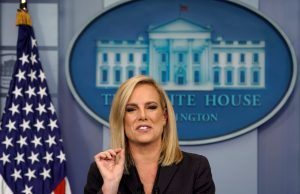
By Gabriela Baczynska
BRUSSELS (Reuters) – The European Union will announce plans next week to strengthen its external borders and push foreign states to do more to deter migrants.
The plans are a last effort by the European Commission led by Jean-Claude Juncker to toughen policy on an issue that has divided Europe since 2015 when more than a million refugees and migrants arrived across the Mediterranean.
But disagreements between EU states make a comprehensive deal on migration unlikely before the new Commission and parliament arrive next year.
Juncker will also propose more pathways for migrants to get to the EU legally including on study or work visas as he makes his last State of the Union speech in the European Parliament next Wednesday before stepping down.
The Commission will release proposals including to enhance the mandate of the bloc’s Frontex agency for external borders, diplomats and officials said.
At the same time Austria, which currently holds the bloc’s presidency, is trying to break a deadlock between member states over how to handle refugees and migrants who arrive by sea.
Under Vienna’s proposal of “mandatory solidarity”, EU states could accept refugees and migrants, provide experts or equipment for the bloc’s external borders or make other contributions.
The plan does not require all member states to host new arrivals. The EU’s ex-communist eastern members oppose hosting these people – just one issue that has damaged the bloc’s unity.
This year, sea arrivals stand at some 70,000 people, a fraction of the mass influx in 2015 that overwhelmed EU states and stretched services, precipitating a rise in the bloc’s populist, nationalist and anti-immigration parties.
“We are still handling an acute political crisis in the EU, even though the arrivals are next to none,” a senior diplomat in Brussels said.
Italy remains opposed to Austria’s plan. Rome has pushed more rigid anti-immigration policies and denied several rescue ships access to its ports. It says other EU states should take in the migrants.
EU leaders will discuss migration again at a summit in Salzburg on Sept. 19-20.

Tents where migrants live are seen in the downtown of Nantes, France, September 6, 2018. REUTERS/Stephane Mahe
ENTRENCHED
They will also discuss stepping up returns and deportations of people who make it to the EU but fail to win asylum.
The EU is entering a campaign season with European Parliament elections due next May and a new Commission to be installed in late 2019.
As a result, member states would have to agree a new migration package this year to give the Parliament a chance to approve it before its final session in mid-April, diplomats say.
The Commission’s new measures further develop policies implemented since 2015 that have contributed to a sharp decrease in migration by sea. Rights groups say the policies leave migrants vulnerable to abuses and death on land and at sea.
The bloc’s idea for “regional disembarkation platforms” around the Mediterranean aimed to open EU ports for rescue ships and then spread the migrants on board across the bloc.
The plan was honed after an EU summit last June that saw Italy and Germany face off through the night. But it appears stillborn as member states remain reluctant to take immigrants in, let alone through an obligatory scheme.
(Editing by Matthew Mpoke Bigg)




